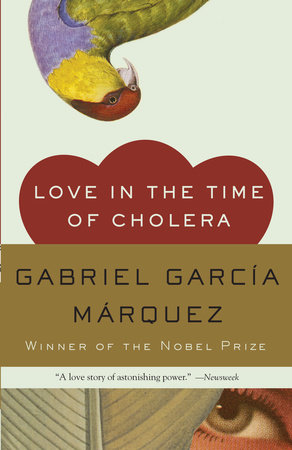Love in the Time of Cholera Reader’s Guide
By Gabriel García Márquez


“A rich, commodious novel whose narrative power is matched only by its generosity of vision.” –The New York Times
The introduction, discussion questions, suggested reading list, and author biography that follow are intended to enhance your group’s reading of Love in the Time of Cholera, Gabriel García Márquez masterful novel of unrequited love.
1. Why does García Márquez use similar terms to describe the effects of love and cholera?
2. Plagues figure prominently in many of García Márquez’s novels. What literal and metaphoric functions does the cholera plague serve in this novel? What light does it shed on Latin American society of the nineteenth century? How does it change its characters’ attitudes toward life? How are the symptoms of love equated in the novel with the symptoms of cholera?
3. What does the conflict between Dr. Juvenal Urbino and Florentino Ariza reveal about the customs of Europe and the ways of Caribbean life? How is Fermina Daza torn between the two?
4. Dr. Urbino reads only what is considered fine literature, while Fermina Daza immerses herself in contemporary romances or soap operas. What does this reveal about the author’s attitude toward the distinction between “high” and “low” literature. Does his story line and style remind you more of a soap opera or a classical drama?
5. After rejecting Florentino’s declaration of love following her husband’s funeral, why is Fermina eventually won over by him?
6. Why does a change in Florentino’s writing style make Fermina more receptive to him?
7. What does Florentino mean when he tells Fermina, before they make love for the first time, “I’ve remained a virgin for you” (p. 339)?
8. Why does Florentino tell each of his lovers that she is the only one he has had?
9. What does Florentino’s uncle mean when he says, “without river navigation there is no love” (p. 168)?
10. Do Fermina and Dr. Urbino succeed at “inventing true love” (p. 159)?
11. Set against the backdrop of recurring civil wars and cholera epidemics, the novel explores death and decay, as well as love. How does Dr. Urbino’s refusal to grow old gracefully affect the other two characters? What does it say about fulfillment and beauty in their society? Does the fear of aging or death change Florentino Ariza’s feelings toward Fermina Daza?
12. Compare the suicide of Jeremiah de Saint-Amour at the beginning of the book with that of Florentino’s former lover, América Vicuña at the end. How do their motives differ? Why does the author frame the book with these two events?
13. Why is Leona Cassiani “the true woman in [Florentino’s] life although neither of them ever knew it and they never made love” (p. 182)?
14. When Tránsito Ariza tells Florentino he looks as if he were going to a funeral when he is going to visit Fermina, why does he respond by saying, “It’s almost the same thing” (p. 65)? (Used by permission of Penguin Books.)
Just for joining you’ll get personalized recommendations on your dashboard daily and features only for members.
Find Out More Join Now Sign In